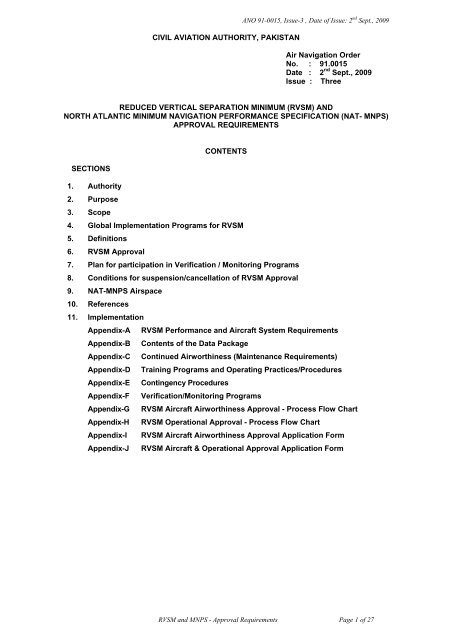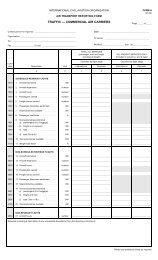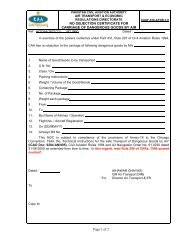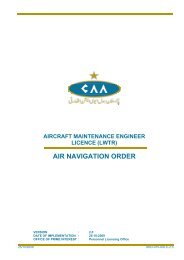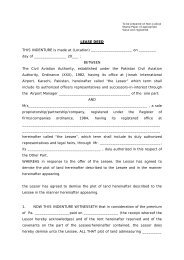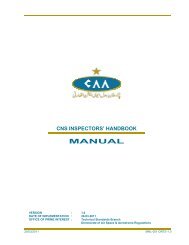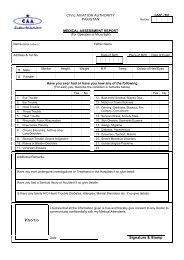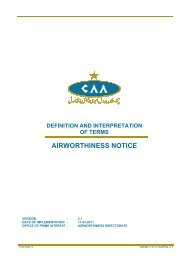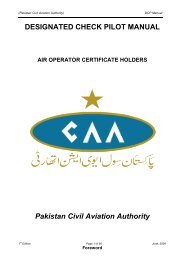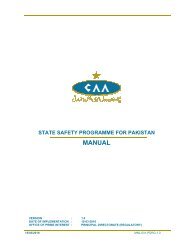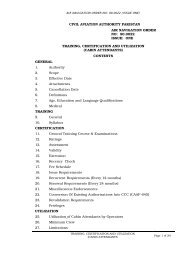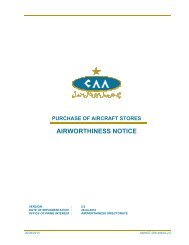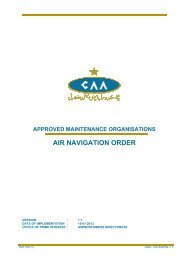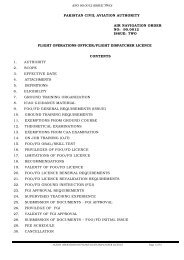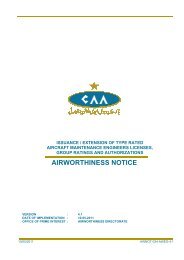reduced vertical separation minimum (rvsm) - Civil Aviation Authority
reduced vertical separation minimum (rvsm) - Civil Aviation Authority
reduced vertical separation minimum (rvsm) - Civil Aviation Authority
Create successful ePaper yourself
Turn your PDF publications into a flip-book with our unique Google optimized e-Paper software.
CIVIL AVIATION AUTHORITY, PAKISTAN<br />
ANO 91-0015, Issue-3 , Date of Issue: 2 nd Sept., 2009<br />
Air Navigation Order<br />
No. : 91.0015<br />
Date : 2 nd Sept., 2009<br />
Issue : Three<br />
REDUCED VERTICAL SEPARATION MINIMUM (RVSM) AND<br />
NORTH ATLANTIC MINIMUM NAVIGATION PERFORMANCE SPECIFICATION (NAT- MNPS)<br />
APPROVAL REQUIREMENTS<br />
CONTENTS<br />
SECTIONS<br />
1. <strong>Authority</strong><br />
2. Purpose<br />
3. Scope<br />
4. Global Implementation Programs for RVSM<br />
5. Definitions<br />
6. RVSM Approval<br />
7. Plan for participation in Verification / Monitoring Programs<br />
8. Conditions for suspension/cancellation of RVSM Approval<br />
9. NAT-MNPS Airspace<br />
10. References<br />
11. Implementation<br />
Appendix-A RVSM Performance and Aircraft System Requirements<br />
Appendix-B Contents of the Data Package<br />
Appendix-C Continued Airworthiness (Maintenance Requirements)<br />
Appendix-D Training Programs and Operating Practices/Procedures<br />
Appendix-E Contingency Procedures<br />
Appendix-F Verification/Monitoring Programs<br />
Appendix-G RVSM Aircraft Airworthiness Approval - Process Flow Chart<br />
Appendix-H RVSM Operational Approval - Process Flow Chart<br />
Appendix-I RVSM Aircraft Airworthiness Approval Application Form<br />
Appendix-J RVSM Aircraft & Operational Approval Application Form<br />
RVSM and MNPS - Approval Requirements Page 1 of 27
CIVIL AVIATION AUTHORITY, PAKISTAN<br />
ANO 91-0015, Issue-3 , Date of Issue: 2 nd Sept., 2009<br />
Air Navigation Order<br />
No. : 91.0015<br />
Date : 2 nd Sept., 2009<br />
Issue : Three<br />
REDUCED VERTICAL SEPARATION MINIMUM (RVSM) AND<br />
NORTH ATLANTIC MINIMUM NAVIGATION PERFORMANCE SPECIFICATION (NAT- MNPS)<br />
APPROVAL REQUIREMENTS<br />
1. AUTHORITY<br />
1.1 This Air Navigation Order (ANO) is issued under Rule 252 of <strong>Civil</strong> <strong>Aviation</strong> Rules (CARs) 94 by<br />
Director General <strong>Civil</strong> <strong>Aviation</strong> <strong>Authority</strong> in pursuance of powers vested in him under Rule-4 of<br />
CARs 1994.<br />
2. PURPOSE<br />
2.1 This ANO provides an acceptable means that can be used by Pakistani Operators to gain<br />
approval for conducting flights in airspace or on routes:<br />
a) At FL 290 and above where a <strong>vertical</strong> <strong>separation</strong> <strong>minimum</strong> (VSM) of 1000 ft is applied in<br />
airspace designated as Reduced Vertical Separation Minimum (RVSM) airspace and in<br />
airspace designated as North Atlantic Minimum Navigation Performance Specification<br />
(NAT-MNPS) Airspace. The approval process described in this ANO covers RVSM<br />
airworthiness approvals/validation for Pakistan/foreign registered aircraft and RVSM<br />
operational approvals for Pakistani Operators operating with Pakistan registered or foreign<br />
aircraft. It also provides:<br />
i) Pakistani aircraft owners and Operators with comprehensive information on a means<br />
of gaining airworthiness and operational approvals for RVSM operations;<br />
ii) Sufficient knowledge to flight crew on RVSM operations to enable them to conduct<br />
operations safely.<br />
b) Designated as NAT-MNPS Airspace.<br />
3. SCOPE<br />
3.1 This ANO applies to all Operators with Pakistan Registered and/or foreign registered aircraft,<br />
and flight crews wishing to conduct flights into airspace designated as Reduced Vertical<br />
Separation Minimum (RVSM) airspace (airspace at FL 290 and above, where a 1000 ft <strong>vertical</strong><br />
<strong>separation</strong> <strong>minimum</strong> is applied) and in airspace designated as NAT-MNPS Airspace.<br />
4. GLOBAL IMPLEMENTATION PROGRAMS FOR MNPS AND RVSM<br />
4.1 A <strong>reduced</strong> <strong>vertical</strong> <strong>separation</strong> <strong>minimum</strong> of 1000 feet was introduced from FL 330 to FL 370 in<br />
parts of the NAT MNPS in 1997. In 1998, this was extended to cover FL 310 to FL 390<br />
inclusive.<br />
5. DEFINITIONS AND ABBREVIATIONS<br />
5.1 Definitions<br />
The following definitions are intended to clarify certain specialized terms used in this ANO.<br />
a) Aircraft Group: A group of aircraft that are of nominally identical design and build with<br />
respect to all details that could influence the accuracy of height keeping performance;<br />
b) Altimetry System Error (ASE): The difference between the pressure altitude displayed to<br />
the flight crew when referenced to ISA standard ground pressure setting (29.92<br />
in.Hg/1013.25 hPa) and free stream pressure altitude;<br />
c) Assigned Altitude Deviation (AAD): The difference between the transponder Mode C<br />
altitude and the assigned altitude/flight level;<br />
d) Automatic Altitude Control System: Any system, which is designed to automatically control<br />
the aircraft to a referenced pressure altitude;<br />
e) Avionics Error (AVE): The error in the processes of converting the sensed pressure into an<br />
electrical output, of applying any static source error correction (SSEC) as appropriate, and<br />
of displaying the corresponding altitude;<br />
RVSM and MNPS - Approval Requirements Page 2 of 27
ANO 91-0015, Issue-3 , Date of Issue: 2 nd Sept., 2009<br />
f) Basic RVSM Envelope: The range of Mach numbers and gross weights within the altitude<br />
ranges FL 290 to FL 410 (or maximum available altitude where an aircraft can reasonably<br />
be expected to operate most frequently;<br />
g) Full RVSM Envelope: The entire range of operational Mach numbers, w/d, and altitude<br />
values over which the aircraft can be operated within RVSM airspace;<br />
h) Height-Keeping Capability: Aircraft height-keeping performance, which can be expected<br />
under nominal environmental operating conditions with proper aircraft operating practices<br />
and maintenance;<br />
i) Height-Keeping Performance: The observed performance of an aircraft with respect to<br />
adherence to a flight level;<br />
j) NAT-MNPS Airspace is defined as follows:<br />
i) Between latitude 27 degrees North and 67 degrees North;<br />
ii) The Eastern Boundaries of Santa Maria Oceanic, Shanwick Oceanic, and Reykjavik<br />
Flight Information Region (FIR);<br />
iii) The Western Boundaries of Reykjavik and Gander Oceanic FIRs and New York FIR<br />
East of longitude 60 degrees West;<br />
iv) Between FL 275 and 400.<br />
k) Non-Group Aircraft: An aircraft for which the Operator applies for approval based on the<br />
characteristics of the unique airframe rather than on a group basis;<br />
l) Residual Static Source Error: The amount by which static source error (SSE) remains<br />
under-corrected or over-corrected after the application of SSEC;<br />
m) RVSM approval data package: It is the combination of performance and analytical data,<br />
service bulletin(s) or equivalent, continued airworthiness instructions, and the approved<br />
amendment or supplement to the AFM;<br />
n) RVSM Airworthiness Approval: RVSM airworthiness approval, in the context of this ANO,<br />
is a written approval given by PCAA for a Pakistani aircraft (i.e. an aircraft registered in<br />
Pakistan) indicating that it is suitable to be operated in RVSM airspace;<br />
o) RVSM Foreign Airworthiness Approval: RVSM foreign airworthiness approval is an<br />
approval given for a foreign aircraft by a competent <strong>Authority</strong> of the country in which the<br />
aircraft is registered indicating that the aircraft is suitable to be operated in RVSM<br />
airspace;<br />
p) RVSM Operational Approval: This approval covers not only the Operator but also each<br />
individual aircraft group and each individual aircraft to be used by the Operator in RVSM<br />
operations.<br />
q) Static Source Error (SSE): The difference between the pressure sensed by the static<br />
system at the static port and the undisturbed ambient pressure;<br />
r) Static Source Error Correction (SSEC): A correction for static source error;<br />
s) Total Vertical Error (TVE): Vertical geometric difference between the actual pressure<br />
altitude flown by an aircraft and its assigned pressure altitude (flight level);<br />
t) Worst-case avionics: Combination of tolerance values, specified by the manufacturer for<br />
the altimetry fit into the aircraft, which gives the largest combined absolute value for<br />
residual SSE plus avionics errors;<br />
6. RVSM APPROVAL: Airspace where RVSM is applied shall be considered special qualification<br />
airspace. Operators and the aircraft they intend to use in the RVSM airspace must be approved by<br />
PCAA before they can conduct flight(s) in RVSM airspace.<br />
6.1 RVSM Airworthiness Approval Requirements<br />
Each aircraft that a Pakistani Operator intends to use in RVSM airspace must have an RVSM<br />
airworthiness approval or an RVSM foreign airworthiness approval before an RVSM<br />
operational approval can be granted by PCAA.<br />
6.1.1 Aircraft Systems and Equipment <strong>minimum</strong> requirement is:<br />
a) Two independent altitude measurement systems;<br />
b) One Secondary Surveillance Radar (SSR) altitude reporting transponder. If only one<br />
is fitted, it shall have the capability for switching to operate from either altitude<br />
measurement system;<br />
c) An altitude alert system;<br />
d) An automatic altitude control system.<br />
6.1.2 Maintenance Program: The Operator shall submit a maintenance program for approval<br />
with following details:<br />
a) Maintenance Practices;<br />
b) Maintenance Practices for Non-Compliant Aircraft;<br />
c) Maintenance Training Requirements;<br />
RVSM and MNPS - Approval Requirements Page 3 of 27
ANO 91-0015, Issue-3 , Date of Issue: 2 nd Sept., 2009<br />
d) Test Equipment.<br />
6.1.3 Maintenance Documents: Following documents are required along with application:<br />
a) Aircraft Flight Manual including all the supplements and amendments;<br />
b) Maintenance Manuals;<br />
c) Structural Repair Manuals;<br />
d) Standards Practices Manuals;<br />
e) Illustrated Parts Catalogues;<br />
f) Maintenance Schedule;<br />
g) MMEL/MEL;<br />
h) Maintenance Control Manuals;<br />
i) Equipment Lists/Wiring Diagram Manuals;<br />
j) RVSM approval data package.<br />
6.1.4 RVSM approval data package: Following shall make up the RVSM approval data<br />
package:<br />
a) Performance and analytical data;<br />
b) Service Bulletin(s) or equivalent;<br />
c) The approved amendment or supplement to the AFM;<br />
d) Compliance Procedures;<br />
e) Operating Restrictions;<br />
f) Continued airworthiness instructions.<br />
6.2 RVSM Airworthiness Approval Process: Obtaining RVSM airworthiness approval is a twostage<br />
process, which may involve more than one <strong>Authority</strong>:<br />
6.2.1 In the case of a newly built aircraft:<br />
a) The aircraft constructor develops and submits the performance and analytical data<br />
that supports the RVSM airworthiness approval of a defined build standard;<br />
b) The data will be supplemented with maintenance and repair manuals giving<br />
associated continued airworthiness instructions;<br />
c) Compliance with RVSM criteria will be stated in the Aircraft Flight Manual (AFM)<br />
including reference to the applicable build standard, related conditions and<br />
limitations;<br />
d) Approval by the responsible <strong>Authority</strong>, or Validation of that approval by other<br />
authorities.<br />
6.2.2 In the case of an aircraft already in service:<br />
a) The aircraft constructor (or an approved design organisation), submits to the<br />
responsible <strong>Authority</strong>, either in the state of manufacture or the state in which the<br />
aircraft is registered, the performance and analytical data that supports RVSM<br />
airworthiness approval of a defined build standard;<br />
b) The data will be supplemented with a Service Bulletin, or its equivalent, that<br />
identifies the work to be done to achieve the build standard, continued airworthiness<br />
instructions;<br />
c) An amendment to the AFM stating related conditions and limitations;<br />
d) Approval by the responsible <strong>Authority</strong>.<br />
6.2.3 Operator shall apply on prescribed form for airworthiness approval of specific aircraft. All<br />
necessary data as mentioned below shall be submitted to the DAW PCAA for necessary<br />
review. The approved data package shall be used by the Operator to demonstrate<br />
compliance with RVSM performance standards. The application will need to be<br />
supported by evidence confirming that:<br />
a) The performance and analytical data is available;<br />
b) Where necessary, modified in accordance with applicable Service Bulletins;<br />
c) It is of a type and build standard that meets the RVSM airworthiness criteria;<br />
d) The approved AFM amendment or supplement has been incorporated;<br />
e) The specific aircraft has been inspected and approved by the responsible <strong>Authority</strong>;<br />
f) The continued airworthiness instructions are available.<br />
6.2.4 Post-Approval Modification: Any variation/modification from the initial installation that<br />
affects RVSM approval shall require clearance by the airframe manufacturer or<br />
approved design organisation and be cleared with PCAA to show that RVSM<br />
compliance has not been impaired.<br />
RVSM and MNPS - Approval Requirements Page 4 of 27
6.2.5 Continued Airworthiness: Refer to Appendix C of this ANO.<br />
6.3 RVSM Operational Approval (FSD PCAA)<br />
ANO 91-0015, Issue-3 , Date of Issue: 2 nd Sept., 2009<br />
6.3.1 RVSM operational approval covers not only the Operator but also each individual<br />
aircraft group and each individual aircraft to be used by the Operator in RVSM<br />
operations. Each aircraft must have received an RVSM airworthiness approval or have a<br />
current RVSM foreign airworthiness approval before it will be listed on an Operator’s<br />
RVSM operational approval.<br />
6.3.2 RVSM Operational Approval: This approval covers not only the Operator but also each<br />
individual aircraft group and each individual aircraft to be used by the Operator in RVSM<br />
operations. Operational Approval pertains to guidance on the operational procedures<br />
and programs, which an Operator shall adopt for RVSM operation.<br />
6.3.3 PCAA shall ensure that each Operator can demonstrate that the Operator’s aircraft can<br />
maintain high levels of height-keeping performance. Flight crew training, Operations<br />
manuals and operational programs will be evaluated for adequacy by Flight Standards.<br />
Approval will be granted for individual Pakistan Operators.<br />
6.3.4 Pre-Application Meeting: A pre-application meeting shall be scheduled on Operator’s<br />
request to discuss PCAA’s requirements and expectations in regard to approval to<br />
operate in a RVSM environment. The content of the Operator’s RVSM application,<br />
PCAA review and evaluation of the application, validation flight requirements, and<br />
conditions for removal of RVSM approval shall be basic items of discussion.<br />
6.3.5 Content/Attachments of Operator RVSM Application: An Operator applying(on<br />
prescribed form) for RVSM approval shall provide to PCAA the following for review and<br />
evaluation at least 45 days prior to the intended start of RVSM operations.<br />
a) Description of Aircraft Equipment<br />
b) Airworthiness Approval Certificate<br />
c) Operations Manuals and Checklists<br />
d) Past Performance<br />
e) Minimum Equipment List<br />
f) Training Programs and Operating Practices/ Procedures<br />
6.4 Review and Evaluation Process<br />
6.4.1 Once the application has been submitted, PCAA will begin the process of review and<br />
evaluation. If the content of the application is insufficient, PCAA will ask for additional<br />
information from the Operator. When all the airworthiness and operational requirements<br />
of the application are met, PCAA will proceed with the approval process.<br />
6.4.2 The PCAA:<br />
a) May evaluate a training course prior to accepting a training certificate;<br />
b) May accept a statement in the Operator’s application that the Operator will ensure<br />
that its pilots will be knowledgeable on RVSM procedures contained in Appendix D;<br />
or<br />
c) May accept a statement by the Operator that it has or will conduct an in-house<br />
training program. Practices and procedures in the following areas shall be<br />
standardised using the guidelines of Appendix D:<br />
i) Flight planning;<br />
ii) Pre-flight procedures at the aircraft for each flight;<br />
iii) Procedures prior to RVSM airspace entry;<br />
iv) In-flight procedures; and<br />
v) Flight crew training procedures.<br />
6.5 Validation Flight (s)<br />
In some cases, the review of the RVSM application and programs may suffice for validation<br />
purposes. However, the final step of the approval process may be the completion of a<br />
validation flights. PCAA Inspectors (Operations & Airworthiness) may accompany the Operator<br />
on a flight through airspace where RVSM is applied to verify that operations and maintenance<br />
procedures and practices are applied effectively.<br />
RVSM and MNPS - Approval Requirements Page 5 of 27
ANO 91-0015, Issue-3 , Date of Issue: 2 nd Sept., 2009<br />
6.6 Approval<br />
RVSM operational approval will only be issued if the RVSM airworthiness approval is in force.<br />
The approval will take the form of a certificate and will identify the Operator, each individual<br />
aircraft the approval covers, and any conditions on the approval (e.g. height monitoring<br />
program to be completed within a specified time of the approval being issued).<br />
7. PLAN FOR PARTICIPATION IN VERIFICATIONS/MONITORING PROGRAMS<br />
7.1 The Operator shall provide a plan for participation in the verification or monitoring program.<br />
This program shall normally entail a check of at least a portion of the Operator's aircraft by an<br />
independent height-monitoring system (Refer to Appendix F for this programme)<br />
8. CONDITIONS FOR SUSPENSION/CANCELLATION OF RVSM APPROVAL<br />
8.1 The incidence of height-keeping errors, which can be tolerated in an RVSM environment, is<br />
very small. It is incumbent upon each Operator to take immediate action to rectify the<br />
conditions, which caused the error. The Operator shall also report the event to PCAA within 24<br />
hours with initial analysis of causal factors and measures to prevent further events. PCAA will<br />
determine the requirement for follow-up reports.<br />
8.2 Following errors caused by either malfunction of aircraft equipment and/or operational errors<br />
shall be reported and investigated:<br />
a) Total <strong>vertical</strong> error (TVE) equal to or greater than ±300 ft (±90 m);<br />
b) Altimetry System Error (ASE) equal to or greater than ±245 ft (±75 m); and<br />
c) Assigned Altitude Deviation (AAD) equal to or greater than ±300 ft (±90 m).<br />
8.3 The Operator shall make an effective, timely response to each height-keeping error. PCAA<br />
may consider suspending/canceling an Operator’s RVSM operational approval if the<br />
Operator’s response to a height-keeping error is unsatisfactory.<br />
9. NAT- MNPS AIRSPACE<br />
9.1 Operational Approval Considerations: Operators desiring to operate in NAT-MNPS airspace<br />
inform the PCAA a <strong>minimum</strong> of 30 days prior to the start of the required evaluation process.<br />
Navigation equipment utilized and the associated operating procedure are the choice of the<br />
Operator. The essential provision is that the combination of equipment and method of<br />
operation meet the navigation accuracy established by ICAO for operations within the<br />
NAT-MNPS airspace.<br />
9.2 Equipment Reliability: In evaluating a navigation system, consideration should be given to<br />
maintaining the highest level of navigational performance. Operators should consider<br />
equipment reliability and human error analysis when evaluating a navigation system for use in<br />
the NAT-MNPS airspace.<br />
9.3 Monitoring and Reporting: To ensure safety is not compromised through failure of Operators<br />
to meet the conditions for operations within the MNPS, ICAO has established procedures for<br />
monitoring of aircraft navigation performance using ATS radar near the boundaries of<br />
NAT-MNPS airspace. Lateral errors in excess of 25 NM will be reported for investigation as<br />
appropriate.<br />
9.4. PCAA shall take appropriate action concerning Operators who frequently fail to meet the<br />
navigation specifications, including restricting flights or withdrawing approval of those<br />
Operators to fly in the NAT-MNPS airspace.<br />
10. REFERENCES<br />
a) ICAO Doc. 9574.<br />
b) ICAO Doc. 7030<br />
c) FAA-91-RVSM (Change 1)<br />
d) FAA Advisory Circular, AC 120-33<br />
e) ICAO Annex 2<br />
RVSM and MNPS - Approval Requirements Page 6 of 27
ANO 91-0015, Issue-3 , Date of Issue: 2 nd Sept., 2009<br />
11. IMPLEMENTATION<br />
This Air Navigation Order shall be implemented with immediate effect and it supersedes ANO<br />
91.0015 Issue-2.<br />
--S/d--<br />
Dated: 2 nd Sept., 2009<br />
(M. JUNAID AMEEN)<br />
Air Commodore (Retd.)<br />
Director General<br />
<strong>Civil</strong> <strong>Aviation</strong> <strong>Authority</strong><br />
RVSM and MNPS - Approval Requirements Page 7 of 27
1. PERFORMANCE<br />
ANO 91-0015, Issue-3 , Date of Issue: 2 nd Sept., 2009<br />
RVSM PERFORMANCE & AIRCRAFT SYSTEM REQUIREMENTS<br />
Appendix A<br />
1.1 General<br />
The statistical performance statements of ICAO Doc. 9574 for a population of aircraft have been<br />
translated into airworthiness standards by assessment of the characteristics of Altimetry System<br />
errors and altitude control. The standards in this ANO are consistent with the requirements of<br />
RVSM as provided in ICAO Doc. 9574.<br />
1.2 RVSM Flight Envelopes<br />
For the purposes of RVSM approval, the aircraft flight envelope may be considered in two parts:<br />
the Basic RVSM Envelope and the Full RVSM Envelope. The Basic RVSM Envelope is the part<br />
of the flight envelope where aircraft operate the majority of time. The Full RVSM Envelope<br />
includes parts of the flight envelope where the aircraft operates less frequently and where a<br />
larger Altimetry System Error tolerance is allowed.<br />
1.3 Altimetry System Error<br />
1.3.1 Factors Affecting ASE<br />
In order to evaluate a system against the ASE performance statements, it is necessary to<br />
quantify the mean and three standard deviation values for ASE, expressed as ASE mean and<br />
(ASE3SD) Altimetry System Error (three standard deviations). In order to do this, it is necessary<br />
to take into account the different ways in which variations in ASE can arise. The factors that<br />
affect ASE are:<br />
a) Unit to unit variability of avionics;<br />
b) Effect of environmental operating conditions on avionics;<br />
c) Airframe to airframe variability of static source error; and<br />
d) Effect of flight operating condition on static source error.<br />
1.3.2 Assessment Requirement<br />
The assessment of Altimetry System Error (mean) and Altimetry System Error (three standard<br />
deviations) whether based on measured or predicted data, must, therefore, cover all the factors<br />
affecting ASE. Evaluating ASE at the most adverse flight condition in an RVSM flight envelope<br />
can eliminate the effect of SSC as a variable.<br />
1.3.3 Basic RVSM Envelope<br />
The requirements in the Basic RVSM Envelope are:<br />
a) At the point in the Basic RVSM Envelope where mean ASE reaches its largest absolute<br />
value, the absolute value shall not exceed 80 ft (25 m); and<br />
b) At the point in the Basic RVSM Envelope where mean ASE plus three standard deviations of<br />
ASE reaches its largest absolute value, the absolute value shall not exceed 200 ft (60 m).<br />
1.3.4 Full RVSM Envelope<br />
The requirements in the Full RVSM Envelope are:<br />
a) At the point in the Full RVSM Envelope where mean ASE reaches its largest absolute value,<br />
the absolute value shall not exceed 120 ft (37 m);<br />
b) At the point in the Full RVSM Envelope where mean ASE plus three standard deviations of<br />
ASE reaches its largest absolute value, the absolute value shall not exceed 245 ft (75 m);<br />
and;<br />
c) If necessary, for the purpose of achieving RVSM approval for an aircraft group, an operating<br />
restriction may be established to restrict aircraft from conducting RVSM operations in areas<br />
of the Full RVSM Envelope where the absolute value of mean ASE exceeds 120 ft (37 m)<br />
and/or the absolute value of mean ASE plus three standard deviations of ASE exceed 245 ft<br />
(75 m). When such a restriction is established, it shall be identified in the data package and<br />
documented in appropriate aircraft operating manuals, however, visual or aural<br />
warning/indication systems shall not be required to be installed on the aircraft.<br />
1.3.5 Aircraft Types<br />
Aircraft types for which application for type certification or major change in type design is made<br />
after 1 January 1997 shall meet the criteria established for the Basic RVSM Envelope in the Full<br />
RVSM Envelope.<br />
RVSM and MNPS - Approval Requirements Page 8 of 27
ANO 91-0015, Issue-3 , Date of Issue: 2 nd Sept., 2009<br />
1.3.6 Interpretation of ICAO Requirements<br />
The standards given above may not apply to non-group aircraft approval because there can be<br />
no group data with which to develop airframe-to-airframe variability. Therefore, a single ASE<br />
value is established that controls the simple sum of the altimetry system errors. In order to<br />
control the overall population distribution, this limit is set at a value less than that for group<br />
approval. The standard for submission of non-group aircraft for approval is:<br />
a) For all conditions in the Basic RVSM Envelope:<br />
Residual static source error + worst case avionics 160 ft (50 m)<br />
b) For all conditions in the Full RVSM Envelope:<br />
Residual static source error + worst case avionics 200 ft (60 m)<br />
1.4 Altitude Keeping<br />
An automatic altitude control system is required and must be capable of controlling altitude<br />
within ±65 ft (±20 m) about the acquired altitude when operated in straight and level flight under<br />
non-turbulent, non-gust conditions.<br />
NOTE: Aircraft types for which application for type certification or major change in type design is<br />
made prior to 1 January 1997 which are equipped with automatic altitude control systems with<br />
flight management system/performance management system inputs allowing variations up to<br />
±130 ft (±40 m) under non-turbulent, non-gust conditions do not require retrofit or design<br />
alteration.<br />
2. Aircraft Systems Requirements<br />
2.1 Equipment for RVSM Operations: The <strong>minimum</strong> equipment fit is:<br />
a) Two independent altitude measurement systems. Each system shall comprise of the<br />
following elements:<br />
i) Cross-coupled static source/system, provided with ice protection if located in areas<br />
subject to ice accretion;<br />
ii) Equipment for measuring static pressure sensed by the static source, converting it to<br />
pressure altitude and displaying the pressure altitude to the flight crew;<br />
iii) Equipment for providing a digitally coded signal corresponding to the displayed pressure<br />
altitude, for automatic altitude reporting purposes;<br />
iv) SSEC, if needed to meet the performance requirements of altimetry system errors, as<br />
appropriate; and<br />
v) The equipment fit shall provide reference signals for automatic control and alerting at<br />
selected altitude. These signals shall preferably be derived from an altitude<br />
measurement system meeting the full requirements of this document, but must in all<br />
cases enable the requirements of Altitude control and altitude alert to be met.<br />
b) One Secondary Surveillance Radar (SSR) altitude reporting transponder. If only one is fitted,<br />
it shall have the capability for switching to operate from either altitude measurement system;<br />
c) An altitude alert system; and<br />
d) An automatic altitude control system.<br />
Note: Details of the above equipment shall be forwarded by the Operator to DAW as an<br />
attachment to application.<br />
2.2 Altimetry<br />
The altimetry system of an aircraft comprises all those elements involved in the process of<br />
sampling free stream static pressure and converting it to a pressure altitude output.<br />
2.2.1 The elements of the altimetry system fall into two main groups:<br />
a) Airframe plus static sources; and<br />
b) Avionics and/or instruments.<br />
2.2.2 Altimetry System Outputs<br />
The following altimetry system outputs are significant for RVSM operations:<br />
a) Pressure altitude (Baro Corrected) display;<br />
b) Pressure altitude reporting data; and<br />
c) Pressure altitude or pressure altitude deviation for an automatic altitude control device.<br />
2.2.3 Altimetry System Accuracy<br />
The total system accuracy shall satisfy the requirements of Basic and full RVSM Envelope or<br />
ICAO standards on the subject, as appropriate.<br />
RVSM and MNPS - Approval Requirements Page 9 of 27
ANO 91-0015, Issue-3 , Date of Issue: 2 nd Sept., 2009<br />
2.2.4 Static Source Error Correction (SSEC)<br />
If the design and characteristics of the aircraft and altimetry system are such that the basic<br />
and/or full RVSM envelope or ICAO standards on the subject, are not satisfied by the location<br />
and geometry of the static sources alone, then suitable Static Source Error Correction (SSEC)<br />
shall be applied automatically within the avionics part of the altimetry system. The design aim for<br />
static source error correction, whether aerodynamic/geometric or avionics, shall be to produce a<br />
<strong>minimum</strong> residual static source error, but in all cases it shall lead to satisfaction of the above<br />
standards, as appropriate.<br />
2.2.5 Altitude Reporting Capability<br />
The aircraft altimetry system shall provide an output to the aircraft transponder.<br />
2.2.6 Altitude Control Output<br />
The requirements are:<br />
a) The altimetry system shall provide an output, which can be used by an automatic altitude<br />
control system to control the aircraft at a commanded altitude. The output may be used<br />
either directly or combined with other sensor signals. If Static Source Error Correction is<br />
necessary in order to satisfy the requirements of this ANO, then an equivalent Static Source<br />
Error Correction (SSEC) must be applied to the altitude control output. The output may be<br />
an altitude deviation signal, relative to the selected altitude, or a suitable absolute altitude<br />
output; and<br />
b) Whatever the system architecture and Static Source Error Correction system the difference<br />
between the output to the altitude control system and the altitude displayed must be kept to<br />
the <strong>minimum</strong>.<br />
2.2.7 Altimetry System Integrity<br />
During the RVSM approval process it must be verified analytically that the predicted rate of<br />
occurrence of undetected altimetry system failures does not exceed 1 x 10-5 per flight hour. All<br />
failures and failure combinations whose occurrence would not be evident from cross-cockpit<br />
checks, and which would lead to altitude measurement/display errors outside the specified<br />
limits, need to be assessed against this budget. No other failures or failure combinations need to<br />
be considered.<br />
2.3 Altitude Alert<br />
The altitude deviation warning system must signal an alert when the altitude displayed to the<br />
flight crew deviates from selected altitude by more than a nominal value. For aircraft for which<br />
application for type certification or major change in type design is made before 1 January 1997,<br />
the nominal value shall not be greater than ±300 ft (±90 m). For aircraft for which application for<br />
type certification or major change in type design is made after 1 January 1997, the nominal<br />
value shall not be greater than ±200 ft (±60 m). The overall equipment tolerance in implementing<br />
these nominal threshold values shall not exceed ±50 ft (±15 m).<br />
2.4 Automatic Altitude Control System<br />
a) As a <strong>minimum</strong>, a single automatic altitude control system must be installed which is capable<br />
of controlling aircraft height within a tolerance band of ±65 ft (±20 m) about the acquired<br />
altitude when the aircraft is operated in straight and level flight under non-turbulent,<br />
non-gust conditions.<br />
Note: Aircraft for which application for type certificates was made prior to 1 January 1997, which<br />
are equipped with automatic altitude control system with flight management system/performance<br />
management system inputs which allow variations up to ±130 ft (±40 m) under non-turbulent,<br />
non-gust conditions do not require retrofit or design alteration.<br />
b) Where an altitude select/acquire function is provided, the altitude select/acquire control<br />
panel must be configured such that an error of no more than ±25 ft (±8 m) exists between<br />
the display selected by the flight crew and the corresponding output to the control system.<br />
RVSM and MNPS - Approval Requirements Page 10 of 27
ANO 91-0015, Issue-3 , Date of Issue: 2 nd Sept., 2009<br />
CONTENTS OF THE DATA PACKAGE<br />
Appendix B<br />
The combination of performance and analytical data, Service Bulletin(s) or equivalent, continued<br />
airworthiness instructions, and the approved amendment or supplement to the AFM is known as the<br />
RVSM approval data package.<br />
1. Scope<br />
As a <strong>minimum</strong>, the data package shall consist of the following:<br />
a) A definition of the aircraft group or non-group aircraft to which the data package applies;<br />
b) A definition of the flight envelope(s) applicable to the subject aircraft;<br />
c) The data needed to show compliance with the requirements;<br />
d) The compliance procedures to be used to ensure that all aircraft submitted for airworthiness<br />
approval meet RVSM requirements; and<br />
e) The engineering data to be used to ensure continued in-service RVSM approval integrity.<br />
2. Aircraft Group<br />
For aircraft to be considered as members of a group for purposes of RVSM approval, they shall<br />
satisfy all of the following conditions:<br />
a) Aircraft shall have been manufactured to a nominally identical design and be approved by<br />
the same Type Certificate (TC), TC amendment, or Supplemental TC, as applicable;<br />
b) The static system of each aircraft shall be installed in a nominally identical manner and<br />
position. The same SSE corrections shall be incorporated in all aircraft of the group;<br />
c) The avionics units installed on each aircraft to meet the <strong>minimum</strong> RVSM equipment<br />
requirements shall be manufactured to the manufacturer's specification and have the same<br />
part number; and<br />
d) The RVSM data package shall have been produced or provided by the airframe<br />
manufacturer or design organisation.<br />
Note 1: For derivative aircraft it may be possible to utilise the database from the parent<br />
configuration to minimise the amount of additional data required to show compliance. The extent<br />
of additional data required will depend on the nature of the changes between the parent aircraft<br />
and the derivative aircraft.<br />
Note 2: Aircraft, which have avionics units that are of a different manufacturer or part number,<br />
may be considered part of the group, if it is demonstrated that this standard of avionics<br />
equipment provides equivalent system performance.<br />
3. Non-Group Aircraft<br />
If an airframe does not meet the conditions to qualify as a member of a group or is presented as<br />
an individual airframe for approval, then it must be considered as a non-group aircraft for the<br />
purposes of RVSM approval.<br />
4. Flight Envelopes<br />
The RVSM flight envelope is defined as the Mach number, W/, and altitude ranges over which<br />
an aircraft can be operated in cruising flight within the RVSM airspace.<br />
The RVSM operational flight envelope for any aircraft may be divided into two zones as defined<br />
below:<br />
a) Full RVSM Envelope<br />
The Full RVSM Envelope shall comprise the entire range of operational Mach number and<br />
altitude values over which the aircraft can be operated within RVSM airspace. Parameters<br />
that shall be considered are:<br />
Lower Boundary is Identified by Upper Boundary is defined by<br />
Altitude FL 290 The lower of the following:<br />
• FL 410<br />
• Aircraft maximum certified altitude<br />
• Altitude limited by cruise thrust, buffet, other<br />
aircraft flight limitations<br />
Mach or<br />
Airspeed<br />
Gross<br />
Weight<br />
The lower of the following:<br />
• Maximum endurance (holding)<br />
speed<br />
• Maneuver Speed<br />
• The lowest gross weight compatible<br />
with operation in RVSM airspace<br />
MMO/VMO<br />
• Speed limited by cruise thrust, buffet, other<br />
aircraft flight limitations<br />
• The highest gross weight compatible with<br />
operation in RVSM airspace<br />
RVSM and MNPS - Approval Requirements Page 11 of 27
ANO 91-0015, Issue-3 , Date of Issue: 2 nd Sept., 2009<br />
b) Basic RVSM Envelope<br />
i) The boundaries for the Basic RVSM Envelope are the same as those for the Full RVSM<br />
Envelope except in regard to the upper Mach boundary.<br />
ii) For the Basic RVSM Envelope, the upper Mach boundary may be limited to a range of<br />
airspeeds over which the aircraft group can reasonably be expected to operate most<br />
frequently. The manufacturer or design organisation shall declare this boundary for each<br />
aircraft group. The boundary may be defined as equal to the upper Mach/airspeed<br />
boundary defined for the Full RVSM Envelope or a specified lower value. This lower<br />
value shall not be less than the Long Range Cruise Mach Number plus 0.04 Mach,<br />
unless limited by available cruise thrust, buffet, or other aircraft flight limitations.<br />
Note: Long Range Cruise Mach number is the Mach for 99% of best fuel mileage at the<br />
particular W/ under consideration.<br />
5. Data Package Requirements<br />
The data package shall contain data sufficient to substantiate that the accuracy standards are<br />
met.<br />
a) General<br />
i) ASE will generally vary with flight condition. The data package shall provide coverage of<br />
the RVSM envelope sufficient to define the largest errors in the basic and full RVSM<br />
envelopes. Note that in the case of group approval the worst flight condition may be<br />
different for each of the requirements and each shall be evaluated.<br />
ii) Where precision flight calibrations are used to quantify or verify altimetry system<br />
performance they may be accomplished by any of the following methods. Flight<br />
calibrations shall only be performed once appropriate ground checks have been<br />
completed. Uncertainties in application of the method must be assessed and taken into<br />
account in the data package. The methods are:<br />
• Precision tracking radar in conjunction with pressure calibration of atmosphere at<br />
test altitude;<br />
• Trailing cone;<br />
• Pacer aircraft; or<br />
• Any other method acceptable to PCAA.<br />
b) Altimetry System Error Budget: It is implicit, for group approvals and for non-group<br />
approvals that a trade may be made between the various error sources, which contribute to<br />
ASE. Separate limits are not specified for the various error sources, which contribute to the<br />
mean and variable components of ASE as long as the overall ASE accuracy requirements<br />
are met. In all cases the trade-off adopted shall be presented in the data package in the<br />
form of an error budget, which includes all significant error sources.<br />
c) Avionics: Avionics equipment shall be identified by function and part number. It shall be<br />
demonstrated that the avionics equipment can meet the requirements established according<br />
to the error budget when the equipment is operated in the environmental conditions<br />
expected to be met during RVSM operations. This equipment must conform to the details<br />
submitted to DAW along with the application.<br />
d) Groups of Aircraft: Where approval is sought for an aircraft group, the data package shall<br />
be sufficient to show that the requirements are met. Because of the statistical nature of<br />
these requirements, the content of the data package may vary considerably from group to<br />
group.<br />
i) The mean and airframe-to-airframe variability of ASE shall be established based on<br />
precision flight test calibration of a number of aircraft. Where analytical methods are<br />
available, it may be possible to enhance the flight test database and to track subsequent<br />
change in the mean and variability based on geometric inspections and bench test or<br />
any other method acceptable to the approving <strong>Authority</strong>. In the case of derivative aircraft<br />
it may be possible to utilise data from the parent as part of the database.<br />
ii) An assessment of the aircraft-to-aircraft variability of each error source shall be made.<br />
The error assessment may take various forms as appropriate to the nature and<br />
magnitude of the source and the type of data available. For some error sources<br />
(especially small ones) it may be acceptable to use specification values to represent<br />
Three standard deviations (3SD). For other error sources (especially larger ones) a<br />
more comprehensive assessment may be required; this is especially true for airframe<br />
error sources where ‘specification’ values of ASE contribution may not have been<br />
previously established.<br />
RVSM and MNPS - Approval Requirements Page 12 of 27
ANO 91-0015, Issue-3 , Date of Issue: 2 nd Sept., 2009<br />
iii) In many cases one or more of the major ASE error sources will be aerodynamic in<br />
nature (such as variations in the aircraft surface contour in the vicinity of the static<br />
pressure source). If evaluation of these errors is based on geometric measurements,<br />
substantiation shall be provided that the methodology used is adequate to ensure<br />
compliance.<br />
iv) An error budget shall be established to ensure that the standards are met. The worst<br />
flight condition may be different for each of these standards and therefore the<br />
component error values may also be different.<br />
v) In showing compliance with the overall requirements, the component error sources shall<br />
be combined in an appropriate manner. In most cases this will involve the algebraic<br />
summation of the mean components of the errors, Root-Sum-Square (RSS)<br />
combination of the variable components of the errors, and summation of the RSS value<br />
with the absolute value of the overall mean. Care shall be taken that only variable<br />
component error sources, which are independent of each other, are combined by RSS.<br />
e) Non-Group Aircraft: Where an aircraft is submitted for approval as a non-group aircraft, the<br />
data shall be sufficient to show that the requirements are met. The data package shall<br />
specify how the ASE budget has been allocated between residual SSE and avionics error.<br />
The following data shall be established.<br />
i) Precision flight-test calibration of the aircraft to establish its ASE or SSE over the RVSM<br />
envelope shall be required. Flight calibration shall be performed at points in the flight<br />
envelope(s) as agreed by the certifying <strong>Authority</strong>. One of the methods prescribed shall<br />
be used.<br />
ii) Calibration of the avionics used in the flight test as required to establish residual SSE.<br />
The number of test points shall be agreed by the certifying <strong>Authority</strong>. Since the purpose<br />
of the flight test is to determine the residual SSE, specially calibrated altimetry<br />
equipment may be used.<br />
iii) Specifications for the installed altimetry avionics equipment indicating the largest<br />
allowable errors will be presented.<br />
iv) If subsequent to aircraft approval for RVSM operation avionics units, which are of a<br />
different manufacturer or part number, are fitted, it shall be demonstrated that the<br />
standard of avionics equipment provides equivalent altimetry system performance.<br />
6. Compliance Procedures<br />
The data package must include a definition of the procedures, inspections/tests and limits which<br />
will be used to ensure that all aircraft approved against the data package ‘conform to type’, and<br />
that all future approvals, whether of new build or in-service aircraft, meet the budget allowances<br />
developed. The budget allowances will be established by the data package and include a<br />
methodology that allows for tracking the mean and SD for new build aircraft. Compliance<br />
requirements must be defined for each potential source of error.<br />
7. Operating Restrictions<br />
Where an operating restriction has been adopted, the package shall contain data and<br />
information necessary to document and establish that restriction.<br />
RVSM and MNPS - Approval Requirements Page 13 of 27
ANO 91-0015, Issue-3 , Date of Issue: 2 nd Sept., 2009<br />
CONTINUED AIRWORTHINESS (MAINTENANCE REQUIREMENTS)<br />
Appendix C<br />
1. General<br />
The integrity of the design features necessary to ensure that altimetry systems continue to meet<br />
RVSM standards shall be verified by scheduled tests and/or inspections in conjunction with an<br />
approved maintenance program. The Operator shall review its maintenance procedures and<br />
address all aspects of continuing airworthiness, which are affected by RVSM requirements.<br />
Each Operator shall demonstrate that adequate maintenance facilities are available to ensure<br />
continued compliance with the RVSM maintenance requirements.<br />
2. Maintenance Program Approval Requirements<br />
Each Operator requesting an RVSM operational approval shall submit a maintenance and<br />
inspection program which includes any maintenance requirements defined in the approved data<br />
package as part of a continued airworthiness (approved system of) maintenance program<br />
approval or an equivalent program approved by PCAA.<br />
3. Maintenance Documents Requirements<br />
The following items shall be reviewed as appropriate for RVSM maintenance approval:<br />
a) Maintenance Manuals;<br />
b) Structural Repair Manuals;<br />
c) Standards Practices Manuals;<br />
d) Illustrated Parts Catalogues;<br />
e) Maintenance Schedule;<br />
f) MMEL/MEL;<br />
g) Maintenance Control Manuals; and<br />
h) Equipment Lists/Wiring Diagram Manuals.<br />
4. Maintenance Practices<br />
If the Operator is subject to an ongoing approved maintenance program, that program shall<br />
contain the maintenance practices outlined in the applicable aircraft and component<br />
manufacturer's maintenance manuals for each aircraft type. The following items shall be<br />
reviewed for compliance and if the Operator is not subject to an approved maintenance program<br />
the following items shall be followed:<br />
a) All RVSM equipment shall be maintained in accordance with the component manufacturer's<br />
maintenance requirements and the performance requirements outlined in the approved data<br />
package;<br />
b) Any modification, repair, or design change, which in any way alters the initial RVSM<br />
approval, shall be subject to a design review by persons approved by the approving<br />
<strong>Authority</strong>;<br />
c) Any maintenance practices which may affect the continuing RVSM approval integrity, e.g.<br />
the alignment of pitot/static probes, dents, or deformation around static plates, shall be<br />
referred to PCAA or to persons delegated by PCAA;<br />
d) Built-In Test Equipment (BITE) testing is not an acceptable basis for system calibrations,<br />
(unless it is shown to be acceptable by the airframe manufacturer with PCAA’s agreement)<br />
and shall only be used for fault isolation and troubleshooting purposes;<br />
e) Some aircraft manufacturers have determined that the removal and replacement of<br />
components utilising quick disconnects and associated fittings, when properly connected,<br />
will not require a leak check. While this approach may allow the aircraft to meet static<br />
system certification standards when properly connected, it does not always ensure the<br />
integrity of the fittings and connectors, nor does it confirm system integrity during component<br />
replacement and re-connections. Therefore, a system leak check or visual inspection shall<br />
be accomplished any time a quick disconnect static line is broken;<br />
f) Airframe and static systems shall be maintained in accordance with the airframe<br />
manufacturer's inspection standards and procedures;<br />
g) To ensure the proper maintenance of airframe geometry for proper surface contours and the<br />
mitigation of altimetry system error, surface measurements or skin waviness checks shall be<br />
made if needed to ensure adherence to the airframe manufacturer's RVSM tolerances.<br />
These tests and inspections shall be performed as established by the airframe<br />
manufacturer. These checks shall also be performed following repairs, or alterations having<br />
an effect of airframe surface and airflow;<br />
h) The maintenance and inspection program for the autopilot shall ensure continued accuracy<br />
and integrity of the automatic altitude control system to meet the height-keeping standards<br />
RVSM and MNPS - Approval Requirements Page 14 of 27
ANO 91-0015, Issue-3 , Date of Issue: 2 nd Sept., 2009<br />
for RVSM operations. This requirement will typically be satisfied with equipment inspections<br />
and serviceability checks; and<br />
i) Where the performance of existing equipment is demonstrated as being satisfactory for<br />
RVSM approval, it shall be verified that the existing maintenance practices are also<br />
consistent with continued RVSM approval integrity.<br />
5. Maintenance Practices for Non-Compliant Aircraft<br />
Those aircraft positively identified as exhibiting height-keeping performance errors that require<br />
investigation, shall not be operated in airspace where RVSM is applied until the following actions<br />
have been taken:<br />
(a) The failure or malfunction is confirmed and isolated by maintenance action; and<br />
(b) Corrective action is carried out as required and verified to ensure RVSM approval integrity.<br />
6. Maintenance Training Requirements<br />
Training requirements shall be provided for RVSM approvals processes. Areas that may need to<br />
be highlighted for initial and recurrent training of maintenance personnel are:<br />
a) Aircraft geometric inspection techniques;<br />
b) Test equipment calibration/usage techniques; and<br />
c) Any special documentation or procedures introduced by RVSM approval.<br />
7. Test Equipment<br />
The test equipment shall have the capability to demonstrate continuing compliance with all the<br />
parameters established for RVSM approval in the initial data package or as approved by the<br />
approving <strong>Authority</strong>.<br />
8. Standards<br />
Test equipment shall be calibrated utilising reference standards whose calibration is certified as<br />
being traceable to the national standard. It shall be calibrated at periodic intervals as agreed by<br />
the approving <strong>Authority</strong>. The approved maintenance program shall encompass an effective<br />
quality control program, which includes the following:<br />
a) Definition of required test equipment accuracy;<br />
b) Regular calibrations of test equipment traceable to a master in-house standard.<br />
Determination of calibration interval shall be a function of the stability of the test equipment.<br />
The calibration interval shall be established on the basis of historical data so that<br />
degradation is small in relation to the required accuracy;<br />
c) Regular audits of calibration facilities both in-house and outside;<br />
d) Adherence to acceptable maintenance practices; and<br />
e) Procedures for controlling Operator errors and unusual environmental conditions which may<br />
affect calibration accuracy.<br />
RVSM and MNPS - Approval Requirements Page 15 of 27
ANO 91-0015, Issue-3 , Date of Issue: 2 nd Sept., 2009<br />
TRAINING PROGRAMS AND OPERATING PRACTICES/PROCEDURES<br />
Appendix D<br />
1. Introduction<br />
Flight crews will need to have an awareness of the criteria for operating in RVSM airspace and<br />
be trained accordingly. The items detailed in this appendix shall be standardised and<br />
incorporated into training programs and operating practices and procedures. Certain items may<br />
already be adequately standardised in existing procedures. New technology may also remove<br />
the need for certain actions required of the flight crew. If this is so, then the intent of this<br />
guidance can be considered to be met.<br />
2. Flight Planning<br />
During flight planning the flight crew shall pay particular attention to conditions that may affect<br />
operation in RVSM airspace. These include, but may not be limited to:<br />
a) Verifying that the airframe is approved for RVSM operations;<br />
b) Reported and forecast weather on the route of flight;<br />
c) Minimum equipment requirements pertaining to height keeping & alerting systems;<br />
d) Any airframe or operating restriction related to RVSM approval.<br />
3. Pre-Flight Procedures at the Aircraft for Each Flight<br />
The following actions shall be carried out during the pre-flight procedure:<br />
a) Review technical logs and forms to determine the condition of equipment required for flight<br />
in RVSM airspace. Ensure that maintenance action has been taken to correct defects to<br />
required equipment;<br />
b) During the external inspection of aircraft, particular attention shall be paid to the condition of<br />
static sources and the condition of the fuselage skin near each static source and any other<br />
component that affects altimetry system accuracy. This check may be accomplished by a<br />
qualified and authorized person other than the pilot (e.g. a flight engineer or ground<br />
engineer);<br />
c) Before takeoff, the aircraft altimeters shall be set to the QNH of the airfield and shall display<br />
a known altitude, within the limits specified in the aircraft operating manuals. The two<br />
primary altimeters shall also agree within limits specified by the aircraft operating manual.<br />
An alternative procedure using QFE may also be used. Any required functioning checks of<br />
altitude indicating systems shall be performed; and<br />
d) Before take-off, equipment required for flight in RVSM airspace shall be operative, and any<br />
indications of malfunction shall be resolved.<br />
4. In-Flight Procedures<br />
4.1 General<br />
The following practices shall be incorporated into flight crew training and procedures:<br />
a) Flight crews will need to comply with any aircraft operating restrictions, if required for the<br />
specific aircraft group, e.g. limits on indicated Mach number, given in the RVSM<br />
airworthiness approval.<br />
b) Emphasis shall be placed on promptly setting the sub-scale on all primary and standby<br />
altimeters to 1013.25 hPa (29.92 in.Hg) when passing the transition altitude, and rechecking<br />
for proper altimeter setting when reaching the initial cleared Flight Level;<br />
c) In level cruise it is essential that the aircraft is flown at the cleared Flight Level. This requires<br />
that particular care is taken to ensure that ATC clearances are fully understood and<br />
followed. The aircraft shall not intentionally depart from cleared Flight Level without a<br />
positive clearance from ATC unless the crew are conducting contingency or emergency<br />
manoeuvres;<br />
d) When changing levels, the aircraft shall not be allowed to overshoot or undershoot the<br />
cleared Flight Level by more than 150 ft (45 m);<br />
Note: It is recommended that the level off be accomplished using the altitude capture feature<br />
of the automatic altitude-control system, if installed.<br />
e) An automatic altitude-control system shall be operative and engaged during level cruise,<br />
except when circumstances such as the need to re-trim the aircraft or turbulence require<br />
disengagement. In any event, adherence to cruise altitude shall be accomplished by<br />
reference to one of the two primary altimeters. Following loss of the automatic height<br />
keeping function, any consequential restrictions will need to be observed;<br />
f) Ensure that the altitude-alerting system is operative;<br />
RVSM and MNPS - Approval Requirements Page 16 of 27
ANO 91-0015, Issue-3 , Date of Issue: 2 nd Sept., 2009<br />
g) At intervals of approximately one hour, cross-checks between the primary altimeters shall be<br />
made. A <strong>minimum</strong> of two will need to agree within ±200 ft (±60 m). Failure to meet this<br />
condition will require that the altimetry system be reported as defective and notified to ATC:<br />
i) The usual scan of flight deck instruments shall suffice for altimeter cross-checking on<br />
most flights;<br />
ii) Before entering RVSM airspace, the initial altimeter cross check of primary and standby<br />
altimeters shall be recorded;<br />
Note: Some systems may make use of automatic altimeter comparators.<br />
h) In normal operations, the altimetry system being used to control the aircraft shall be selected<br />
for the input to the altitude reporting transponder transmitting information to ATC;<br />
i) If the pilot is advised in real time that the aircraft has been identified by a height-monitoring<br />
system as exhibiting a TVE greater than ±300 ft (± 90 m) and/or an ASE greater than ±245 ft<br />
(±75 m) then the pilot shall follow established regional procedures to protect the safe<br />
operation of the aircraft. This assumes that the monitoring system will identify the TVE or<br />
ASE within the set limits for accuracy; and<br />
j) If the pilot is notified by ATC of an assigned altitude deviation, which exceeds ±300 ft<br />
(±90 m) then the pilot shall take action to return to the cleared Flight Level as quickly as<br />
possible.<br />
4.2 Procedures Prior to RVSM Airspace Entry<br />
The following equipment must be operating normally for entry into RVSM airspace:<br />
a) Two primary altitude measurement systems;<br />
b) One automatic altitude-control system;<br />
c) One altitude-alerting device; and<br />
d) An operating transponder.<br />
Note: Dual equipment requirements for altitude-control systems will be established by regional<br />
agreement after an evaluation of criteria such as mean time between failures, length of flight<br />
segments and availability of direct pilot controller communications and radar surveillance.<br />
Note: An operating transponder may not be required for entry into all designated RVSM<br />
airspace. The Operator shall determine the requirement for an operational transponder in each<br />
RVSM area where operations are intended. The Operator shall also determine the transponder<br />
requirements for transition areas next to RVSM airspace.<br />
Note: If any of the required equipment fail prior to the aircraft entering RVSM airspace, the pilot<br />
must request a new clearance to avoid entering this airspace.<br />
4.3 Contingency Procedures after Entering RVSM Airspace<br />
The pilot shall notify ATC of contingencies (equipment failures, weather), which affect the ability<br />
to maintain the cleared Flight Level, and co-ordinate a plan of action appropriate to the airspace<br />
concerned. Examples of equipment failures, which shall be notified, to ATC are:<br />
a) Failure of all automatic altitude-control systems aboard the aircraft;<br />
b) Loss of redundancy of altimetry systems;<br />
c) Loss of thrust on an engine necessitating descent; or<br />
d) Any other equipment failure affecting the ability to maintain cleared Flight Level; The pilot<br />
shall notify ATC when encountering greater than moderate turbulence. If unable to notify<br />
ATC and obtain an ATC clearance prior to deviating from the cleared Flight Level, the pilot<br />
shall follow any established contingency procedures and obtain ATC clearance as soon as<br />
possible.<br />
5. Post-Flight Procedures<br />
In making technical log entries against malfunctions in height keeping systems, the pilot shall<br />
provide sufficient detail to enable maintenance to effectively troubleshoot and repair the system.<br />
The pilot shall detail the actual defect and the crew action taken to try to isolate and rectify the<br />
fault. The following information shall be recorded when appropriate:<br />
a) Primary and standby altimeter readings.<br />
b) Altitude selector setting.<br />
c) Sub-scale setting on altimeter.<br />
d) Autopilot used to control the aeroplane and any differences when an alternative autopilot<br />
system was selected.<br />
e) Differences in altimeter readings, if alternate static ports selected. Use of air data computer<br />
selector for fault diagnosis procedure.<br />
f) The transponder selected to provide altitude information to ATC and any difference noted.<br />
RVSM and MNPS - Approval Requirements Page 17 of 27
ANO 91-0015, Issue-3 , Date of Issue: 2 nd Sept., 2009<br />
6. Special Emphasis Items: The following items shall also be included in crew training:<br />
a) Knowledge and understanding of standard ATC phraseology used in each area of<br />
operations;<br />
b) Importance of crew members cross-checking each other to ensure that ATC clearances are<br />
promptly complied with;<br />
c) Use and limitations in terms of accuracy of stand-by altimeters in contingencies. Where<br />
applicable, the pilot shall review the application of static source error correction/position<br />
error correction through the use of correction cards (note: such correction data will need to<br />
be readily available on the flight deck);<br />
d) Problems of visual perception of other aircraft at 1 000ft (300m) planned <strong>separation</strong> during<br />
night conditions, when encountering local phenomena such as northern lights, for opposite<br />
and same direction traffic, and during turns;<br />
e) Characteristics of aircraft altitude capture systems which may lead to the occurrence of<br />
overshoots;<br />
f) Relationship between altimetry, automatic altitude control, and transponder systems in<br />
normal and abnormal situations; and<br />
g) Any airframe operating restrictions, if required for a specific aircraft group, related to an<br />
RVSM airworthiness approval.<br />
RVSM and MNPS - Approval Requirements Page 18 of 27
ANO 91-0015, Issue-3 , Date of Issue: 2 nd Sept., 2009<br />
1. The basic concepts for contingencies are:<br />
CONTINGENCY PROCEDURES<br />
Appendix- E<br />
a) Guidance for contingency procedures shall not be interpreted in any way, which prejudices the<br />
final <strong>Authority</strong> and responsibility of the pilot in command for the safe operation of the aircraft.<br />
b) If the pilot is unsure of the <strong>vertical</strong> or lateral position of the aircraft or the aircraft deviates from<br />
its assigned altitude or track for cause without prior ATC clearance, then the pilot must take<br />
action to mitigate the potential for collision with aircraft on adjacent routes or flight levels. In this<br />
situation, the pilot should alert adjacent aircraft by making maximum use of aircraft lighting and<br />
broadcasting position, flight level, and intentions on 121.5 MHz (as a back-up, the appropriate<br />
VHF inter-pilot air-to-air frequency may be used);<br />
c) Unless the nature of the contingency dictates otherwise, the pilot should advise ATC as soon<br />
as possible of a contingency situation and if possible, request an ATC clearance before<br />
deviating from the assigned route or flight level.<br />
d) If a revised ATC clearance cannot be obtained in a timely manner and action is required to<br />
avoid potential conflict with other aircraft, then the aircraft should be flown at an altitude and/or<br />
on a track where other aircraft are least likely to be encountered. This can be accomplished by<br />
offsetting from routes or altitudes normally flown in the airspace. The recommendations on the<br />
order of preference for pilot actions are:<br />
i) The pilot may offset half the lateral distance between routes or tracks.<br />
ii) The pilot may offset half the <strong>vertical</strong> distance between altitudes normally flown.<br />
iii) The pilot may also consider descending below FL 285 or climbing above FL 410.<br />
e) When executing a contingency maneuver the pilot should:<br />
i) Watch for conflicting traffic both visually and by reference to ACAS, if equipped.<br />
ii)<br />
Continue to alert other aircraft using 121.5 MHz (as a back-up, the VHF inter-pilot air- to-air<br />
frequency may be used) and aircraft lights.<br />
iii) Continue to fly offset tracks or altitudes until an ATC clearance is obtained.<br />
iv) Obtain an ATC clearance as soon as possible.<br />
2. Guidance to the Pilot (Including Expected ATC Actions) in the Event of Equipment Failures<br />
or Encounters with Turbulence after Entry into RVSM Airspace.<br />
In addition to emergency conditions that require immediate descent, such as loss of thrust or<br />
pressurization, ATC should be made aware of the less explicit conditions that may make it<br />
impossible for an aircraft to maintain its CFL appropriate to RVSM. Controllers should react to such<br />
conditions but these actions cannot be specified, as they will be dynamically affected by the realtime<br />
situation.<br />
a) Objective: The following material is provided with the purpose of giving the pilot guidance on<br />
actions to take under certain conditions of equipment failure and encounters with turbulence. It<br />
also describes the expected ATC controller actions in these situations. It is recognized that the<br />
pilot and controller will use judgment to determine the action most appropriate to any given<br />
situation. For certain equipment failures, the safest course of action may be for the aircraft to<br />
maintain the assigned FL and route while the pilot and controller take precautionary action to<br />
protect <strong>separation</strong>. For extreme cases of equipment failure, however, the safest course of<br />
action may be for the aircraft to depart from the cleared FL or route by obtaining a revised ATC<br />
clearance or if unable to obtain prior ATC clearance, executing the established contingency<br />
maneuvers for the area of operation.<br />
b) Contingency Scenarios. These scenarios summarize pilot actions to mitigate the potential for<br />
conflict with other aircraft in certain contingency situations. These should be reviewed in<br />
conjunction with the expanded contingency scenarios detailed in Paragraph 3, which contain<br />
additional technical and operational detail.<br />
RVSM and MNPS - Approval Requirements Page 19 of 27
ANO 91-0015, Issue-3 , Date of Issue: 2 nd Sept., 2009<br />
Scenario 1:<br />
The pilot is:<br />
1) Unsure of the <strong>vertical</strong> position of the aircraft due to the loss or degradation of all primary<br />
altimetry systems, or<br />
2) Unsure of the capability to maintain CFL due to turbulence or loss of all automatic<br />
altitude control systems.<br />
The Pilot should:<br />
Maintain CFL while evaluating the situation;<br />
Watch for conflicting traffic both visually and by reference to ACAS, if equipped;<br />
If considered necessary, alert nearby aircraft by<br />
1) Making maximum use of exterior lights;<br />
2) Broadcasting position, FL, and intentions on 121.5 MHz (as a back up, the VHF inter-pilot air-toair<br />
frequency may be used).<br />
ATC can be expected to:<br />
Notify ATC of the situation and intended<br />
course of action. Possible courses of<br />
action include:<br />
1) Maintaining the CFL and route<br />
provided that ATC can provide lateral,<br />
longitudinal or conventional <strong>vertical</strong><br />
<strong>separation</strong>.<br />
2) Requesting ATC clearance to climb<br />
above or descend below RVSM airspace<br />
if the aircraft cannot maintain CFL and<br />
ATC cannot establish adequate<br />
<strong>separation</strong> from other aircraft.<br />
3) Executing the Doc 7030<br />
contingency maneuver to offset from the<br />
assigned track and FL, if ATC clearance<br />
cannot be obtained and the aircraft<br />
cannot maintain CFL.<br />
Obtain the pilot's intentions and pass essential traffic<br />
information.<br />
1) If the pilot intends to continue in RVSM<br />
airspace, assess traffic situation to determine if the<br />
aircraft can be accommodated through the provision<br />
of lateral, longitudinal, or conventional <strong>vertical</strong><br />
<strong>separation</strong>, and if so, apply the appropriate <strong>minimum</strong>.<br />
2) If the pilot requests clearance to exit RVSM<br />
airspace, accommodate expeditiously, if possible.<br />
3) If adequate <strong>separation</strong> cannot be established and<br />
it is not possible to comply with the pilot's request for<br />
clearance to exit RVSM airspace, advise the pilot of<br />
essential traffic information, notify other aircraft in the<br />
vicinity and continue to monitor the situation.<br />
4) Notify adjoining ATC facilities/sectors of the<br />
situation.<br />
Scenario 2:<br />
There is a failure or loss of accuracy of one primary altimetry system (e.g.,<br />
greater than 200 foot difference between primary altimeters)<br />
The Pilot should<br />
Cross check standby altimeter, confirm the accuracy of a primary altimeter system and notify ATC of<br />
the loss of redundancy. If unable to confirm primary altimeter system accuracy, follow pilot actions<br />
listed in the preceding scenario.<br />
3. Expanded Equipment Failure and Turbulence Encounter Scenarios: Operators may<br />
consider this material for use in training programs.<br />
Scenario 1:<br />
All automatic altitude control systems fail (e.g., Automatic Altitude Hold).<br />
The Pilot should: Initially<br />
Maintain CFL<br />
Evaluate the aircraft's capability to maintain altitude through manual control.<br />
Subsequently<br />
Watch for conflicting traffic both visually and by reference to TCAS, if equipped.<br />
If considered necessary, alert nearby aircraft by<br />
1) Making maximum use of exterior lights;<br />
2) Broadcasting position, FL, and intentions on 121.5 MHz (as a back-up, the VHF inter-pilot air-toair<br />
frequency may be used.)<br />
Notify ATC of the failure and intended course of<br />
ATC can be expected to<br />
action. Possible courses of action include:<br />
RVSM and MNPS - Approval Requirements Page 20 of 27
ANO 91-0015, Issue-3 , Date of Issue: 2 nd Sept., 2009<br />
1) Maintaining the CFL and route, provided<br />
that the aircraft can maintain level.<br />
2) Requesting ATC clearance to climb above<br />
or descend below RVSM airspace if the aircraft<br />
cannot maintain CFL and ATC cannot establish<br />
lateral, longitudinal or conventional <strong>vertical</strong><br />
<strong>separation</strong>.<br />
3) Executing the contingency maneuver to<br />
offset from the assigned track and FL, if ATC<br />
clearance cannot be obtained and the aircraft<br />
cannot maintain CFL.<br />
1) If the pilot intends to continue in<br />
RVSM airspace, assess traffic situation to<br />
determine if the aircraft can be accommodated<br />
through the provision of lateral, longitudinal, or<br />
conventional <strong>vertical</strong> <strong>separation</strong>, and if so, apply<br />
the appropriate <strong>minimum</strong>.<br />
2) If the pilot requests clearance to exit<br />
RVSM airspace, accommodate expeditiously, if<br />
possible.<br />
3) If adequate <strong>separation</strong> cannot be<br />
established and it is not possible to comply with<br />
the pilot's request for clearance to exit RVSM<br />
airspace, advise the pilot of essential traffic<br />
information, notify other aircraft in the vicinity and<br />
continue to monitor the situation.<br />
4) Notify adjoining ATC facilities/ sectors<br />
of the situation.<br />
Scenario 2:<br />
Loss of redundancy in primary altimetry systems<br />
The Pilot should<br />
If the remaining altimetry system is functioning<br />
normally, couple that system to the automatic<br />
altitude control system, notify ATC of the loss of<br />
redundancy and maintain vigilance of altitude<br />
keeping.<br />
ATC can be expected to<br />
Acknowledge the situation and continue to<br />
monitor progress<br />
Scenario 3:<br />
The primary altimeters diverge by more than 200ft (60m)<br />
The Pilot should<br />
Attempt to determine the defective system through established trouble-shooting procedures and/or<br />
comparing the primary altimeter displace to the standby altimeter (as corrected by the correction cards,<br />
if required).<br />
If the defective system can be determined, couple the functioning altimeter system to the altitude<br />
keeping device.<br />
If the defective system cannot be determined, follow the guidance in Scenario 3 for failure or unreliable<br />
altimeter indications of all primary altimeters.<br />
Scenario 4:<br />
All primary altimetry systems are considered unreliable or fail:<br />
The Pilot should<br />
Maintain CFL by reference to the standby altimeter (if the aircraft is so equipped).<br />
Alert nearby aircraft by<br />
1) Making maximum use of exterior lights;<br />
2) Broadcasting position, FL, and intentions on 121.5 MHz (as a back-up, the VHF inter-pilot air-to-air<br />
frequency may be used).<br />
ATC can be expected to<br />
Consider declaring an emergency. Notify<br />
ATC of the failure and intended course of<br />
action. Possible courses of action include:<br />
1) Maintaining CFL and route provided that<br />
ATC can provide lateral, longitudinal or<br />
conventional <strong>vertical</strong> <strong>separation</strong>.<br />
2) Requesting ATC clearance to climb<br />
above or descend below RVSM airspace<br />
if ATC cannot establish adequate<br />
<strong>separation</strong> from other aircraft.<br />
3) Executing the Doc 7030 contingency<br />
maneuver to offset from the assigned<br />
Obtain pilot's intentions, and pass essential traffic<br />
information.<br />
1) If the pilot intends to continue in RVSM airspace,<br />
assess traffic situation to determine if the aircraft can<br />
be accommodated through the provision of lateral,<br />
longitudinal, or conventional <strong>vertical</strong> <strong>separation</strong>, and<br />
if so, apply the appropriate <strong>minimum</strong>.<br />
2) If the pilot requests clearance to exit RVSM airspace,<br />
accommodate expeditiously, if possible.<br />
3) If adequate <strong>separation</strong> cannot be established and it is<br />
not possible to comply with the pilot's request for<br />
RVSM and MNPS - Approval Requirements Page 21 of 27
ANO 91-0015, Issue-3 , Date of Issue: 2 nd Sept., 2009<br />
track and FL, if ATC clearance cannot be<br />
obtained.<br />
clearance to exit RVSM airspace, advise the pilot of<br />
essential traffic information, notify other aircraft in the<br />
vicinity and continue to monitor the situation.<br />
4) Notify adjoining ATC facilities/sectors of the situation.<br />
Scenario 5: Turbulence (greater than moderate) which the pilot believes will impact the<br />
aircraft's capability to maintain flight level.<br />
The Pilot should<br />
Watch for conflicting traffic both visually and by reference to TCAS, if equipped.<br />
If considered necessary, alert nearby aircraft by:<br />
1) Making maximum use of exterior lights;<br />
2) Broadcasting position, FL, and intentions on 121.5 MHz (as a back-up, the VHF inter-pilot air-to-air<br />
frequency may be used).<br />
Notify ATC of intended course of action as soon ATC can be expected to<br />
as possible. Possible courses of action include:<br />
1) Maintaining CFL and route provided ATC can<br />
provide lateral, longitudinal or conventional<br />
<strong>vertical</strong> <strong>separation</strong>.<br />
1) Assess traffic situation to determine if the<br />
aircraft can be accommodated through the<br />
provision of lateral, longitudinal, or<br />
conventional <strong>vertical</strong> <strong>separation</strong>, and if so,<br />
apply the appropriate <strong>minimum</strong>.<br />
2) Requesting flight level change, if necessary. 2) If unable to provide adequate <strong>separation</strong>,<br />
advise the pilot of essential traffic information<br />
and request pilot's intentions.<br />
3) Executing the Doc 7030 contingency<br />
maneuver to offset from the assigned track<br />
and FL, if ATC clearance cannot be obtained<br />
and the aircraft cannot maintain CFL.<br />
3) Notify other aircraft in the vicinity and<br />
monitor the situation<br />
4) Notify adjoining ATC facilities/ sectors of the<br />
situation.<br />
4. Special Procedures for In-Flight Contingencies Published for Individual ICAO Regions in<br />
Doc 7030.<br />
a) The Doc 7030 should be considered the source document for specific contingency procedures<br />
applicable to individual ICAO regions. Doc 7030 should always be consulted before training<br />
material or manuals are developed.<br />
b) In-flight contingency procedures applicable to Pacific oceanic operations are published in<br />
paragraph 4.0 of the Regional Supplementary Procedures for the Pacific and the Middle<br />
East/Asia (Mid/Asia).<br />
c) In-flight contingency procedures applicable to NAT oceanic operations are published in<br />
paragraph 5.0 of NAT Regional Supplementary Procedures.<br />
5. Wake Turbulence Procedures.<br />
These procedures provide for the contingency use of a 2 NM lateral offset to avoid exposure to<br />
wake turbulence. The procedures are published in NOTAMS, AIPs, and Regional Supplementary<br />
Procedures. These procedures should be incorporated in pilot training programs and manuals.<br />
6. Transponder Failure and RVSM Transition Areas.<br />
Transition areas are planned to be established between airspaces where different <strong>vertical</strong><br />
<strong>separation</strong> standards are applied. The specific actions that ATC will take in the event of transponder<br />
failure in RVSM transition areas will be determined by the provider States.<br />
RVSM and MNPS - Approval Requirements Page 22 of 27
ANO 91-0015, Issue-3 , Date of Issue: 2 nd Sept., 2009<br />
VERIFICATION/MONITORING PROGRAMS<br />
Appendix- F<br />
1. General<br />
A program to monitor or verify aircraft height-keeping performance is considered a necessary<br />
element of RVSM implementation for at least the initial area where RVSM is implemented. A<br />
height-monitoring system based on Global Positioning System (GPS) satellites or an earthbased<br />
system may fulfill this function. However, it is expected that most Pakistan Operators will<br />
employ a GPS-based Monitoring System (GMS).<br />
2. Monitoring Agency for Asian Region (MAAR)<br />
MAAR is the agency responsible for this function in the Asian region. Current RVSM <strong>minimum</strong><br />
monitoring requirements and information on GMS flights are detailed in MAAR website<br />
http://www.aerothai.co.th/maar. It is anticipated that the necessity for such programs may be<br />
diminished or possibly eliminated after confidence is gained that RVSM programs are working<br />
as planned. MAAR website has all the necessary Forms i.e. F1& F2 and guidance for procedure<br />
to be followed for monitoring programme. Subject material on MAAR website is not included in<br />
this ANO as it is likely to change. Monitoring can only be undertaken after PCAA has issued an<br />
RVSM approval for the aircraft or group of aircraft.<br />
RVSM and MNPS - Approval Requirements Page 23 of 27
ANO 91-0015, Issue-3 , Date of Issue: 2 nd Sept., 2009<br />
RVSM AIRCRAFT AIRWORTHINESS APPROVAL - PROCESS FLOW CHART<br />
Appendix- G<br />
Operator to apply for<br />
Operational Approval<br />
Operator: To submit following to PCAA as an<br />
attachment to application:<br />
a) Technical Certification from manufacturer for<br />
RVSM modification package;<br />
b) Certificate of Compliance to confirm that all<br />
relevant modifications, inspections and<br />
changes in Maintenance Planning Data<br />
(MPD), are consistent to the requirements;<br />
c) Approval from responsible <strong>Authority</strong>;<br />
d) List of RVSM equipment<br />
Operator to amend<br />
Documentation as<br />
required and resubmit<br />
No<br />
Documents Scrutiny<br />
by PCAA Airworthiness<br />
1. Does the application<br />
provide all the required<br />
details?<br />
2. Are the attachments<br />
complete in<br />
accordance with ANO?<br />
Yes<br />
No<br />
Airworthiness<br />
Assessment<br />
1. Is RVSM foreign<br />
airworthiness approval<br />
valid?<br />
2. Does the Aircraft meet<br />
the requirements for<br />
approval?<br />
Yes<br />
Approval<br />
The PCAA will grant RVSM Airworthiness<br />
Approval Certificate of the aircraft and<br />
send the document to the Operator<br />
RVSM and MNPS - Approval Requirements Page 24 of 27
ANO 91-0015, Issue-3 , Date of Issue: 2 nd Sept., 2009<br />
RVSM OPERATIONAL APPROVAL - PROCESS FLOW CHART<br />
OPERATOR<br />
Appendix- H<br />
Operator to submit following to FSD<br />
PCAA as an attachment to application:<br />
a) Description of Aircraft Equipment<br />
b) Airworthiness Approval Certificate<br />
c) Revised Operations Manuals &<br />
Checklists<br />
d) Height Keeping Past Performance<br />
e) Revised Minimum Equipment List<br />
f) RVSM Training Programs & Operating<br />
Practices/ Procedures<br />
Operator:<br />
1. To comply with<br />
Operational Approval<br />
2. Put up a plan with<br />
MAAR for<br />
participation in the<br />
verification or<br />
monitoring program<br />
Operator to amend<br />
Documentation/procedures<br />
as required and resubmit<br />
No<br />
Documents Scrutiny<br />
by FSD PCAA<br />
1. Does the application<br />
provide all the required<br />
details?<br />
2. Are the attachments<br />
complete in<br />
accordance with ANO?<br />
Yes<br />
No<br />
Review & Evaluation<br />
1. Is RVSM airworthiness<br />
approval valid?<br />
2. Is validation flight(s)<br />
required and if so,<br />
completed?<br />
3. Does the Operator &<br />
Aircraft(s) meet the<br />
requirements for<br />
approval?<br />
Yes<br />
Approval<br />
The PCAA will grant RVSM<br />
Approval Certificate to Operator<br />
RVSM and MNPS - Approval Requirements Page 25 of 27
ANO 91-0015, Issue-3 , Date of Issue: 2 nd Sept., 2009<br />
RVSM AIRCRAFT AIRWORTHINESS APPROVAL APPLICATION FORM<br />
Appendix-I<br />
Part 1 – Operator Details<br />
1. Operator 2. Aircraft Registration 3. Aircraft Type 4. Date<br />
5. Operator’s Address:<br />
6. Is the aircraft approved for RVSM operation by the manufacturer?<br />
if yes attach manufacturer’s comments (for issue only).<br />
7. Whether any component change required for RVSM approval?<br />
If this change is not covered in SB then Engineering Change Order has been raised or not<br />
(for issue only).<br />
8. Whether new task cards or any other additional maintenance added in the MPD for continued<br />
Airworthiness? Attach list and statement that these cards have been carried out.<br />
9. Attach the following:<br />
a) SB, SIL or any other guidelines from manufacturer for RVSM<br />
b) MEL amended pages.<br />
10. Any other details<br />
11. Applicant’s Name 12. Position 13. Signature<br />
Part 2 - Scrutiny<br />
1. Comments by Senior Surveyor: (Include results of inspection of aircraft)<br />
Part 3- Approval by DAW<br />
1. Comments by DAW/Senior Surveyor:<br />
2. Any Limitations and/or Conditions:<br />
3. Name and Signature of Approving <strong>Authority</strong> 4.Position 5.Date<br />
RVSM and MNPS - Approval Requirements Page 26 of 27
ANO 91-0015, Issue-3 , Date of Issue: 2 nd Sept., 2009<br />
RVSM AIRCRAFT & OPERATIONAL APPROVAL APPLICATION FORM<br />
Appendix- J<br />
Part 1 – Operator Details<br />
1. Operator 2. Aircraft Registration 3. Aircraft Type(s) 4. Date<br />
5. Operator’s Address:<br />
6. Has the aircraft been approved for RVSM operation by the DAW?<br />
7. If yes to No 6, attach the following documents:<br />
a) Description of Aircraft Equipment<br />
b) Airworthiness Approval Certificate<br />
c) Revised Operations Manuals & Checklists<br />
d) Height Keeping Past Performance<br />
e) Revised Minimum Equipment List<br />
f) RVSM Training Programs & Operating Practices/ Procedures<br />
g) Any other related information<br />
8. Is Monitoring required by MAAR?<br />
9. If yes, state whether on Global Positioning System (GPS) satellites or GPS-based Monitoring System<br />
(GMS):<br />
10. Applicant’s Name 11. Position 12. Signature<br />
Part 2 - Scrutiny<br />
1. Comments by POI: (Include results of verification flight / inspection of Operator & aircraft)<br />
Part 3- Approval by DFS<br />
1. Comments by DFS/POI:<br />
2. Any Limitations and/or Conditions:<br />
3. Name and Signature of Approving <strong>Authority</strong> 4.Position 5.Date<br />
RVSM and MNPS - Approval Requirements Page 27 of 27


